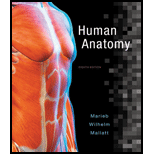
Concept explainers
Describe the location of the apical region of an epithelial tissue. How can this region be easily identi�ed in a micrograph?
To review:
The apical surface of an epithelial tissue and its identification in a micrograph.
Introduction:
The epithelial tissue is a lining of cells covering body surfaces and cavities. The cells forming the epithelial tissue are closely bound together through specialized intercellular junctions. This tissue performs various functions such as protection, filtration, diffusion, secretion, absorption, and sensory reception. It rests upon a layer of connective tissue that provides nutritional support.
Explanation of Solution
A characteristic feature of epithelial cells is their polarization into apical and basal region which are distinguished on the basis of their position. The protein composition and function of apical and basal membrane varies and the tight junctions prevent the free passage of molecules between adjacent cells.
The apical region of an epithelial tissue is present at the top of the epithelial tissue and is directly exposed to the external environment. In simple epithelial tissue composed of a single layer of cells, the apical region of the cell faces toward the lumen or the external environment and the basal region sits on a layer of connective tissue. The stratified epithelium is composed of multiple layer of cells in which the apical region of topmost layer is exposed to the external environment and the basal region of the bottom layer rests on the connective tissue.
In a micrograph, the apical region of an epithelial tissue is identified as the region exposed to an empty space.
Want to see more full solutions like this?
Chapter 4 Solutions
Human Anatomy (8th Edition)
- calculate the questions showing the solution including variables,unit and equations all the questiosn below using the data a) B1, b) B2, c) hybrid rate constant (1) d) hybrid rate constant (2) e) t1/2,dist f) t1/2,elim g) k10 h) k12 i) k21 j) initial concentration (C0) k) central compartment volume (V1) l) steady-state volume (Vss) m) clearance (CL) AUC (0→10 min) using trapezoidal rule n) AUC (20→30 min) using trapezoidal rule o) AUCtail (AUC360→∞) p) total AUC (using short cut method) q) volume from AUC (VAUC)arrow_forwardQUESTION 8 For the following pedigree, assume that the mode of inheritance is X-linked recessive, and that the trait has full penetrance and expressivity and occurs at a very low frequency in the hum population. Using XA for the dominant allele and Xa for the recessive allele, assign genotypes for the following individuals (if it is not possible to figure out the second allele of a genotype, that with an underscore): 2 m 1 2 1 2 4 5 6 7 8 9 IV 1 2 3 5 6 7 8 CO 9 10 12 13 V 1, 2 3 4 5 6 7 8 9 10 11 12 13 a. Il-1: b. 11-2: c. III-3: d. III-4: e. If individuals IV-11 and IV-12 have another child, what is the probability that they will have a boy with the disorder?arrow_forwardAnswerrarrow_forward
- please,show workings ahd solutions calculate the questions showing the solution including variables,unit and equations all the questiosn below using the data a) B1, b) B2, c) hybrid rate constant (1) d) hybrid rate constant (2) e) t1/2,dist f) t1/2,elim g) k10 h) k12 i) k21 j) initial concentration (C0) k) central compartment volume (V1) l) steady-state volume (Vss) m) clearance (CL) AUC (0→10 min) using trapezoidal rule n) AUC (20→30 min) using trapezoidal rule o) AUCtail (AUC360→∞) p) total AUC (using short cut method) q) volume from AUC (VAUC)arrow_forwardQuestion about consensus and the relationship to transcriptional activityarrow_forwardQuestion about archaea and eukaryotic general transcription homologsarrow_forward
- Question about general transcription factors and their relationship to polymerasesarrow_forwardIdentify the indicated structure?arrow_forwardrewrite: Problem 1 (Mental Health): The survivor victim is dealing with acute stress and symptoms of a post-traumatic stress disorder (PTSD) due to their traumatic experience during the January 2025 wildfire. Goal 1: To alleviate the client's overall level, frequency, and intensity of anxiety and PTSD symptoms so that daily functioning remains unimpaired. Objective 1: The client will learn and regularly use at least two anxieties management techniques to reduce anxiety symptoms to less than three episodes per week. Intervention 1: The therapist will provide psychoeducation about anxiety and PTSD, including their symptoms and triggers. The therapist will also teach and assist the client in adopting relaxation techniques, such as deep breathing exercises and progressive muscle relaxation, to better manage anxiety and lessen PTSD symptoms.arrow_forward
- O Macmillan Learning You have 0.100 M solutions of acetic acid (pKa = 4.76) and sodium acetate. If you wanted to prepare 1.00 L of 0.100 M acetate buffer of pH 4.00, how many milliliters of acetic acid and sodium acetate would you add? acetic acid: mL sodium acetate: mLarrow_forwardHow does the cost of food affect the nutritional choices people make?arrow_forwardBiopharmaceutics and Pharmacokinetics:Two-Compartment Model Zero-Order Absorption Questions SHOW ALL WORK, including equation used, variables used and each step to your solution, report your regression lines and axes names (with units if appropriate) :Calculate a-q a) B1, b) B2, c) hybrid rate constant (1) d) hybrid rate constant (2) e) t1/2,dist f) t1/2,elim g) k10 h) k12 i) k21 j) initial concentration (C0) k) central compartment volume (V1) l) steady-state volume (Vss) m) clearance (CL) AUC (0→10 min) using trapezoidal rule n) AUC (20→30 min) using trapezoidal rule o) AUCtail (AUC360→∞) p) total AUC (using short cut method) q) volume from AUC (VAUC)arrow_forward
 Principles Of Radiographic Imaging: An Art And A ...Health & NutritionISBN:9781337711067Author:Richard R. Carlton, Arlene M. Adler, Vesna BalacPublisher:Cengage LearningSurgical Tech For Surgical Tech Pos CareHealth & NutritionISBN:9781337648868Author:AssociationPublisher:Cengage
Principles Of Radiographic Imaging: An Art And A ...Health & NutritionISBN:9781337711067Author:Richard R. Carlton, Arlene M. Adler, Vesna BalacPublisher:Cengage LearningSurgical Tech For Surgical Tech Pos CareHealth & NutritionISBN:9781337648868Author:AssociationPublisher:Cengage Human Physiology: From Cells to Systems (MindTap ...BiologyISBN:9781285866932Author:Lauralee SherwoodPublisher:Cengage Learning
Human Physiology: From Cells to Systems (MindTap ...BiologyISBN:9781285866932Author:Lauralee SherwoodPublisher:Cengage Learning





